Pages of the Sea: Nationwide project remembers soldiers who fell during Great War
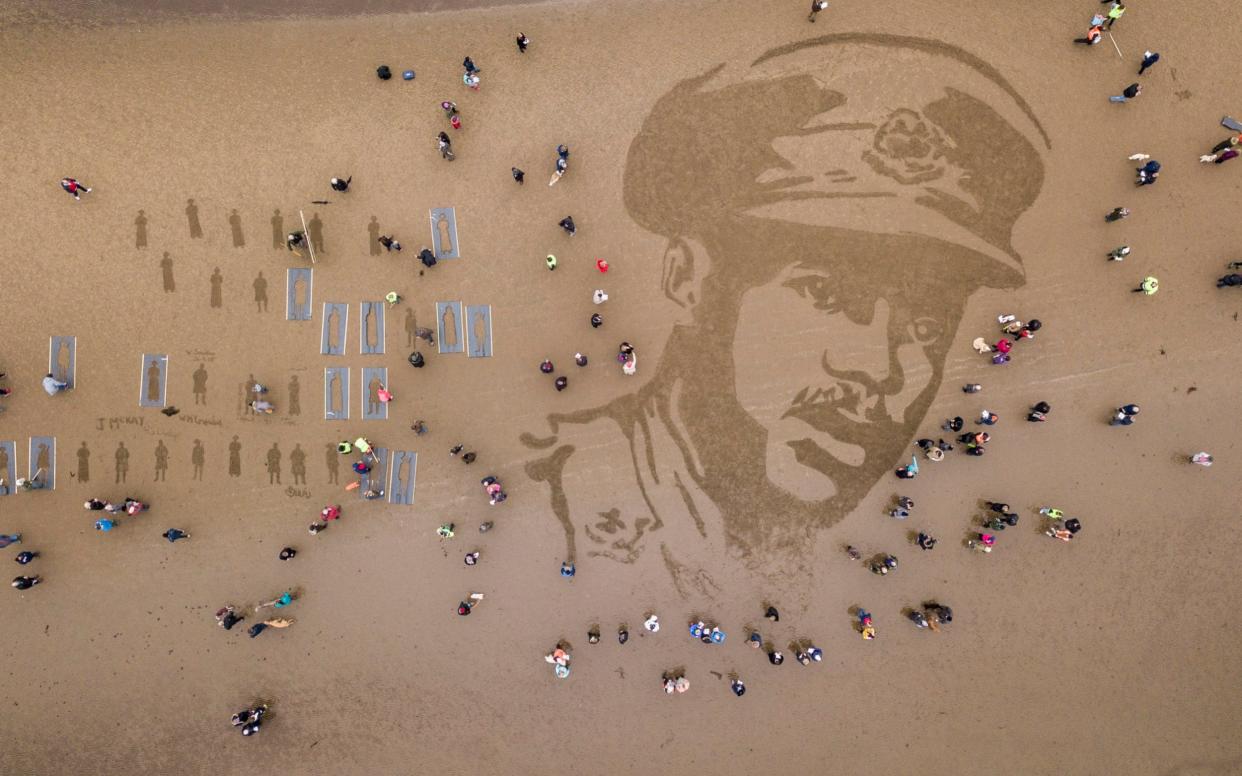
It was the most ephemeral of tributes, yet all the more poignant for it. This morning, under the cloak of darkness and scored only by the sound of waves lapping on sand, hundreds of volunteers took to beaches across the British Isles to take part in a unique commemoration of those who gave the ultimate sacrifice.
On a day that featured countless original acts of remembrance alongside traditional Armistice Day services, ‘Pages of the Sea’, a public art project curated by Oscar-winning filmmaker Danny Boyle for the First World War centenary, saw dozens of vast ‘sand portraits’ of casualties from the conflict etched into our coastline.
In all, 32 beaches took part – from St Ninian’s on Shetland to Porthcurno in Cornwall – with volunteers at each creating images of individuals connected to the local area.
Second Lieutenant Walter Tull, the first ever black officer to command white troops, was remembered by locals in Ayr, Ayrshire.
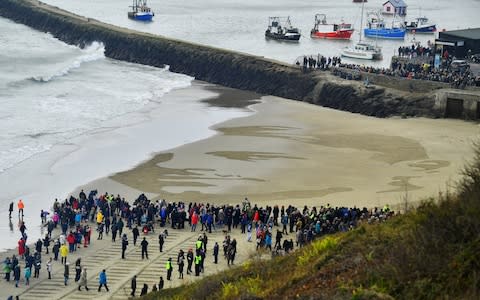
On the opposite coast, Dr Elsie Inglis, an avowed suffragist and founder of the Scottish Women’s Hospitals, appeared on West Sands, Fife.
And in Redcar, North Yorkshire, it was Private Theophilus Jones who had his moment. During the war, Private Jones is believed to have been the first military casualty on British soil from enemy fire.
The portraits were drawn at low tide by teams of seven artists delicately wielding garden rakes. When they were completed a few hours later, crowds had just moments to absorb the haunting faces gazing back at them. Then, with solemn inevitability, the seas claimed the fallen once more.
In Folkestone, Kent, where Mr Boyle was in attendance to witness the likeness of war poet Lieutenant Wilfred Owen carved into Sunny Sands, the day’s events began with the pre-dawn skirl of bagpipes. At 6am, the time at which the Armistice of Compiègne was signed 100 years earlier, a lone piper could be heard playing the traditional lament ‘Battles O’er’ at Memorial Arch.
A mile down the coast, members of the artistic collective Sand In Your Eye – who trained the all the volunteer crews around the country – had already been on the beach for hours. As they raked and plotted, deep navy clouds gave way to a powder blue sky flecked with magnificent ochre.

Then came the rain: obstinate, rascal, November rain driven horizontal by the squalls. Fortunately a bit of weather never deters a Briton in want of a day out, and the crowds proved it: as the 60ft image of Lt Owen’s face grew clear at 9am, hundreds had filled the harbour.
As Mr Boyle noted, Folkestone is a town inextricably linked with the Great War. “This was the artery through which millions of service personnel left to serve.
“Wilfred Owen [did] twice, never to return after the second time,” he told the BBC’s Andrew Marr Show. “The portrait has been created within the tide so as the tide returns, it will take him.”
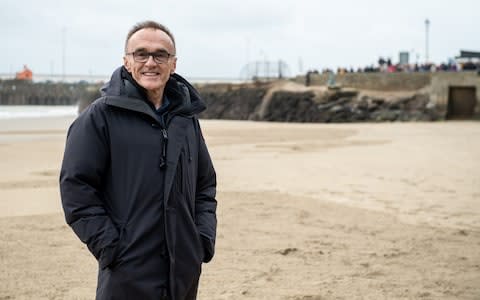
Approximately 10m troops and ancillary personnel passed through Folkestone on their way to the Western Front in the four years Britain was at war. Lt Owen left for a final time in August 1918 – he was killed on November 4. Today, many of the crowd at Sunny Sands arrived via the Road of Remembrance, formerly known as Slope Road, where soldiers were ordered to ‘step short’ down the steep hill to the harbour. Others came down Tontine St, where more than 60 civilians were killed on May 25th 1917, in the first raid carried out by aeroplanes in British history.
With the tides closing in around the country, members of the public were invited onto the beaches and given the chance to create their own sand portraits using stencils of soldiers. Young and old took turns with the rakes; everybody wished to leave their mark.
Louise Leszczyk had travelled from Birmingham with her mother, Margaret, and daughters, Imogen, 14, and nine-year-old Holly. “It was important to us to come down and be here, especially for the children. It’s a lovely and very simple idea,” she said.

Holly, who was wearing a bright pink hoodie and brave face as she shivered by the shore, helped carve one of hundreds of silhouettes in Folkestone. “I’m glad we came, because they fought so we could be here,” she said.
Corporal Peter Wiltshire, 61, a Northern Ireland veteran who arrived wearing the uniform of the 1st Battalion The Royal Green Jackets, attends an Armistice Service every year.
“I’ve never seen anything like this. It’s a brilliant idea. I cry every time I hear the Last Post, and I’m getting choked up now.”
When the rain ceased, people filled every inch of the harbour to hear a local choir read ‘The Wound In Time’, a sonnet written for the day by poet laureate Carol Ann Duffy.
It was the same everywhere. Tides times meant Murlough Beach in Northern Ireland was one of the first to have a complete portrait; there, organisers estimated more than a thousand spectators turned out.
As the 11th hour struck at Sunny Sands, the waves had all but claimed Lt Owen. The crowd fell silent and watched one of our Glorious Dead disappear again. On shores around the nation, the unforgotten were fading before our eyes. It was a solemn reminder of the evanescence of life, but if anything was proven today, it is that we will remember them.
Those remembered in the sands
Sunny Sands, Folkestone, Kent
Lt. Wilfred Owen the famous war poet, who was killed in action aged 25 just one week before the armistice.
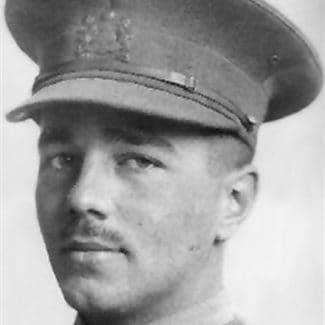
Weymouth, Dorest
Sgt Stanley Robert McDougall, an Australian awarded the Victoria cross after single-handedly capturing an enemy machine gun during a German attack at Dernancourt, France, and then repelling the second wave. He survived the war.
Lyme Regis, Dorset
Rifleman Kulbir Thapa, the first Gurkha awarded the Victoria Cross for rescuing three wounded comrades under fire at Fauquissart, France in 2015. He also survived the war.
Saunton Sands, Devon
Capt Ralph George Griffiths Cumine-Robson, a member of the Royal Engineers killed just before Christmas 1914 in action near Neuve Chapelle.
Weston-Super-Mare, Somerset
Lt Col John Hay Maitland Hardyman, the became youngest lieutenant colonel ever commissioned in the army at age 23. He was killed at Bienvillers, France in 1918.
Swansea, Wales
Dorothy Mary Watson was killed aged 18, along with five other workers, in the Pembrey munitions factory explosion in 1917.
Porthcurno, Cornwall
Lt Richard Charles Graves-Sawle, who left for the front a week after getting married in July 1914 and was killed by a sniper bullet at Ypres three months later.
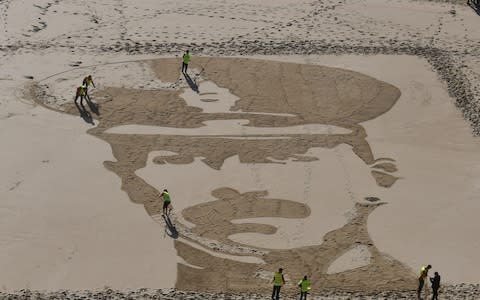
East Looe, Cornwall
Capt Kenneth Walton Grigson, one of five brothers all killed in the First World War. He died weeks before the Armistice.
Porthmeor, Cornwall
Capt Edward Hain who was killed by artillery fire in Gallipoli in 2015.
Perranporth, Cornwall
Archie Jewell, went to sea age 15 and survived the Titanic but died three years later when the hospital ship he was serving on was torpedoed in 1915.
Freshwater West, Pembrokeshire
Major Charles Morris, a gifted rower who lifted the Ladies Plate at Henley. He died in a German hospital after being wounded in La Courcelette and left in nomansland.
Murlough, County Down
Rifleman John McCance who was one of thousands killed in the bloody Battle of Passchendaele. Has no known grave.
Dunree Beach, Donegal
Seaman John Buckley, one of 354 people who died when the SS Laurentic struck two mines in the Atlantic in 1917.
Downhill, Londonderry
Staff nurse Rachel Ferguson, a volunteer nurse who died in June 1918 while serving in Italy after contracting bronco-pneumonia.

Ynyslas, Ceredigion
Richard Davies, a labourer and Royal Naval Reservist, who served on the HM Trawler Evangel. He perished along with 24 other crewmen when it hit a mine in the Irish sea in 1917.
Colwyn Bay, Conwy
Pte Ellis Humphrey Evans, the famous Welsh war poet known as Hedd Wyn who was killed at the Battle of Passchendaele in 1917.
Culla Bay, Benbecula
Duncan MacKinnon, one of six brothers who fought in the war. He died when the H.M. Armed Trawler 'Corona' was sunk near Ramsgate, Kent.
Scapa Beach, Orkney
Lt Robert William Taylor, awarded the Military Cross for directing the fire of his battery guns to break up the German advance at Battle of Passchendaele. Was fatally wounded later in the battle in 1917.
Roseisle Beach, Moray
Capt Charles Hamilton Sorley, a Scottish war poet who was shot in the head by a sniper during the Battle of Loos.
Ayr, Ayrshire
Lt Walter Tull one of the first black professional footballers with Tottenham Hotspur, he went on to become the first black officer to command white troops. He was shot dead at Arras fending off the Germans Spring Offensive in March 1918.

Formby, Merseyside
Capt John Basil Armitage, trained soldiers before being drafted to the front. He was killed by a stray shell in 1917.
Blackpool, Lancashire
Lt Cpl John Arkwright, shipped out to France in August 1914, four months after getting married. He died three days later in the battle of Le Cateau fighting a fierce regard following the Battle of Mons.
West Sands, Fife
Dr Elsie Maud Inglis, a suffragette and surgeon who set up female-staffed relief hospitals and died of cancer in 1917.
Seahouses, Northumberland
Pte William Jonas played for Clapton Orient (now Leyton Orient). He was killed climbing out of his trench during the Battle of the Somme in 1916, moments after telling his friend to send his ‘best regards to the lads at Orient’.
Redcar, North Yorkshire
Pte Theophilus Jones, the first military casualty after he died in the bombing of Hartlepool in 1914.
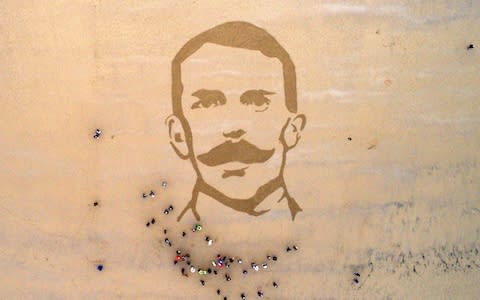
Sutton-on-Sea, Lincolnshire
Lt Basil Perrin Hicks a graduate of Rugby School and Trinity College Cambridge. He was killed in action of the first day of the Battle of Loos and buried on the battlefield.
Brancaster, Norfolk
Driver Stephen Hewitt, served in Salonika in Greece and died from his wounds in 1916 after being savaged by wolves when out riding.
Roker Sunderland
Lt Hugh Carr, transferred from the Household Cavalry to the Royal Engineers tunnelling company to use his experience as a miner. Was killed when a shell landed near his trench at Ypres in 1916.
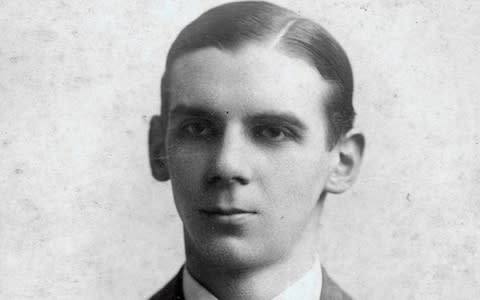
Sutton-on-Sea, Lincolnshire
Lt Basil Perrin Hicks a graduate of Rugby School and Trinity College Cambridge. He was killed in action of the first day of the Battle of Loos and buried on the battlefield.
Brancaster, Norfolk
Driver Stephen Hewitt, served in Salonika in Greece and died from his wounds in 1916 after being savaged by wolves when out riding.
Portstewart Strand, Londonderry
Public were invited to draw their own people in the sand
St Ninian’s Beach Shetland
Silhouettes of servicemen and women being drawn
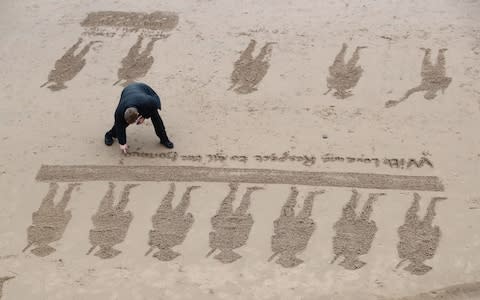
Gorleston, Norfolk
Silhouettes of servicemen and women being drawn
Clacton-on-Sea, Essex
Silhouettes of servicemen and women being drawn

 Yahoo News
Yahoo News 
